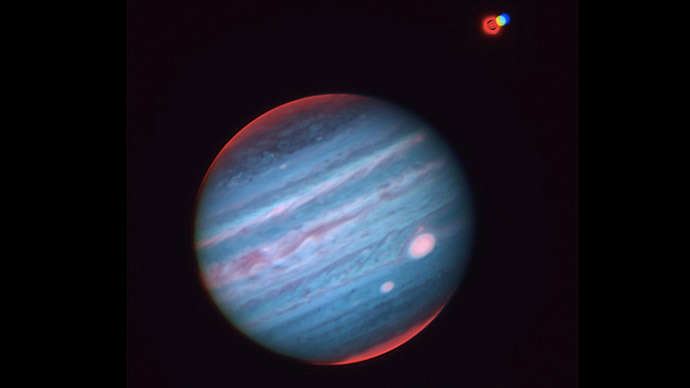Jupiter's 'Great Red Spot' shows true colors, glows white in new infrared image

The largest planet in the Solar System, Jupiter, is known for its giant red storm, the “Great Red Spot” twice the size of the Earth. In a new infrared image by the National Astronomical Observatory of Japan the massive storm appears surprisingly white.
Although detailed images are usually taken by planetary probes or
space-based telescopes, Jupiter was photographed by IRCS
(Infrared Camera and Spectrograph) mounted on the Subaru
Telescope, an 8.2-meter optical-infared instrument at the summit
of Mauna Kea volcano on Hawaii's Big Island.
According to National Astronomical Observatory of Japan, it
succeeded in capturing the details of Jupiter with a level of
precision equal to planetary probe missions or the Hubble Space
Telescope thanks to the adaptive optics which correct for
turbulence in the Earth’s atmosphere.
Apart from the Great Red Spot the image also shows Ganymede, a satellite of Jupiter and the largest moon in the Solar System, in the upper right. Moving relative to Jupiter, it appears stretched into a “rainbow” in the image, because Ganymede moved during the time required to take the picture.
Jupiter's Great Red Spot imaged by Voyager 1 in Jan-Feb 1979 (NASA/JPL) http://t.co/1aVTADVWrtpic.twitter.com/FE7ZLIrbtk
— Jason Major (@JPMajor) February 11, 2015

Jupiter's Great Red Spot has raged from 200 to 350 years, and shows no signs of slowing. According to NASA, like most astronomical phenomena, the massive storm was neither predicted nor immediately understood after its discovery. About 20,000 kilometers long and 12,000 kilometers wide, it was first recorded in 1831 but may have first been discovered as long ago as 1665.
READ MORE: Gigantic ring system 200 times larger than Saturn discovered (PHOTOS)
Thermal images obtained with European Southern Observatory's (ESO) Very Large Telescope and other powerful ground-based telescopes in 2010 showed swirls of warmer air and cooler regions never seen before within the Great Red Spot. The images gave scientists a long-awaited opportunity to make the first detailed interior weather map of the giant storm system linking its temperature, winds, pressure and composition with its color. The observations revealed that the reddest color of the Great Red Spot corresponds to a warm core within the otherwise cold storm system, according to ESO. Images featured dark lanes at the edge of the storm where gases are descending into the deeper regions of the planet.












